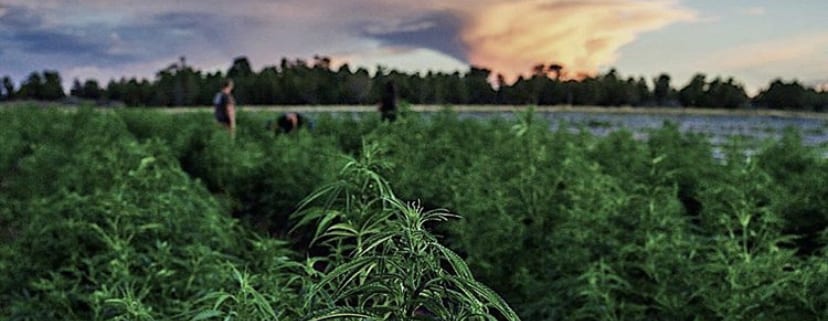Many small-scale farms are family operations, but keeping a hemp farm running with only the efforts of a small group of people may not be possible. Hemp can be a labor-intensive crop, especially when harvest time comes around. To make sure you get your harvest in, it might be time to consider bringing on hemp farm labor.
How do you find the right hemp farmworkers? And as you’re hiring and budgeting, you’ll have to ask yourself, “How much do hemp farmworkers get paid?” Many hemp farmers around the country are facing these questions in real-time. The relatively recent legalization of hemp farming in America means these answers are still developing. In this article, we’ll provide our best guidance and tips on how to find and manage hemp farm labor.
Do You Need Hemp Farm Labor?
A few good farmhands can go a long way in managing and harvesting most crops, especially when equipment can perform most of the work. For example, if you plant hemp for seeds, you can harvest your crop with a combine and very little human labor.
However, harvesting hemp flowers for CBD or CBG is different. Hemp buds are delicate and bruise easily. They can also become contaminated if they are not handled gently. While effective hemp specific harvest equipment is evolving, the best way to harvest hemp flowers currently is by hand. In fact, the 2019 Hemp and CBD Factbook put out by Hemp Industry Daily found that 63% of hemp was harvested by hand in 2019. Harvesting hemp by hand isn’t fast or easy. Workers typically cut the flowers using a sharp instrument, such as a machete, shearer, or tobacco knife.
Farmers are also on a punishing clock. Those who live in more volatile climates may need to harvest their mature hemp flower before an early frost or hurricane season hits. Additionally, THC levels rise quickly as a hemp plant matures, and a delay in harvesting can tip the balance, sending plants over the 0.3% THC threshold, which can ruin an entire crop.
Farmers need to be smart about harvesting their hemp flower quickly and effectively, which could require the use of hemp farm labor. If you’ve never hired hemp farmworkers before, you’ll need to plan carefully to make sure you can find enough workers, train them properly, keep them through the harvest, and meet federal and local employment law.
Tip 1: Start Small
Many farmers underestimate how much labor they’ll need to manage and harvest their hemp crop, which can lead to harvesting delays and financial pain. The best way to prevent this from happening is to start small. Consider planting a single acre of hemp your first year so that you can get an idea of how much time and effort your crop will require. This is also a great opportunity for you to test your soil, learn how to cultivate the crop, and get a sense of how well your seeds perform.
Tip 2: Accurately Estimate Your Hemp Labor Needs
The last thing you want to do is realize you have too few hands in the middle of your harvest. If you followed the first tip and started small during your first year of hemp farming, you should be able to estimate how many people you’ll need to help you harvest a larger field. However, if you plan on jumping in with both feet, then consider that Kentucky hemp farmer Joseph Sisk estimated that he needed one laborer for every five acres in an article for Ag Pro Magazine. Sisk also reported that it took his crew five weeks to harvest his 200 acres of hemp. Make sure you continue to test throughout your harvest and grow your labor force if your THC levels begin to rise.
Tip 3: Consider Staggering Your Harvest
Want to get more work from a smaller crew? If you live in a climate with a long grow window, consider staggering your planting so you won’t have to harvest your entire hemp crop at the same time. A staggered harvest means you can hire fewer laborers who can harvest over a longer period of time. Choosing autoflowers or early finishing hemp strains, along with full-term hemp seeds to round out the harvest, will help you spread out the maturation time of your crop.
Tip 4: Determine Your Workforce
Once you know how many laborers you’ll need, it’s time to consider what your workforce will look like. If you’re only planting a few acres, you may be able to hire and manage your own laborers. However, as your acreage, and, therefore, your workforce grows, you may need to implement another level of management. This is when it might be time to consider hiring hemp farm labor management, like labor supervisors and foremen. As your operation continues to grow, you may also wish to bring on a hiring manager, a payroll supervisor, and other “back office” staff.
Tip 5: Find Your Workers
Where will you find your farm laborers? Smaller farms may be able to bring in extended family members for the harvest, wrangle up adult children, or hire their neighbors or local kids who need some extra money. As your operation grows, it may become more difficult to cover your labor needs using your informal network, and you may need to formalize your search.
Larger operations may want to consider using the H-2 visa program to bring foreign workers to their farm. This program is meant to allow U.S. employers to fill needed jobs when they can’t find an adequate amount of U.S. workers. Over the past few decades, the H-2 visa program has become increasingly popular in the agricultural sector, but it isn’t for the faint of heart.
As Hemp Industry Daily explains, tapping into the H-2 visa program is neither easy nor cheap. You’ll face a challenging bureaucratic landscape and be expected to pay contract fees and visa costs while also covering your workers’ transportation, housing, and living needs. Unsurprisingly, many farmers hire specialists, including hemp farm labor contractors, to help them manage this process and to recruit workers from over the border.
Tip 6: Budget for Your Laborers
At the time of this writing, farm labor is scarce, which means farmers across the country are fighting for the remaining labor talent. In an article for Successful Farming, Miranda Drive of CalAgJobs wrote that there are two jobs available in agriculture for every new job seeker and four jobs for every applicant in California.
This means you may need to pay more for your laborers to be competitive and attract enough workers for your harvest. If money is tight, think outside the box. The California Institute for Rural Studies found that, even above fair compensation, farmworkers most appreciate respectful treatment and a slower pace of work. The report also suggested farmers could offer year-round employment, health insurance, and personal loans to entice farmworkers.
Tip 7: Follow Labor Laws
Are your workers employees or independent contractors? Do they qualify for certain federal or state-mandated benefits? Labor laws are complex and differ from state to state. It’s a smart idea to consult with a labor attorney before you begin formally hiring anyone to work on your farm. Even if you think you have a “handshake deal” with your workers, it’s always better to follow the laws and cover yourself rather than be blindsided by a lawsuit in the future. By implementing proper labor procedures now, you can lay a good groundwork as your hemp farm and your labor force grows into the future.
Tip 8: Accept Your Role as a Manager and Leader
You may simply want to work your land and focus on your crops, but running a farm means you have to wear many different hats. The moment you hire hemp farmworkers, you become a manager. Even if you hire labor supervisors, the buck stops with you. Accept your role and plan accordingly. It’s a good idea to outline your workers’ job duties, develop training programs, and institute strong channels of communication. This should go without saying, but treat your workers with respect and listen to their concerns. Compensate them fairly. The better you treat your workers, the more likely they’ll work harder for you and either stick with you long term or return for the next harvest season.
The Time to Think About Hemp Farm Labor Is Now
Hemp farm labor management may not be a role some farmers feel comfortable with, but it’s just one more part of running your farm business. As your hemp farm grows, the earlier you can start planning for your labor needs, the better. If the labor shortage continues, you’ll need to be smart about defining your labor needs, developing your compensation plan, and searching for reliable and productive workers. If you think you might want to try the H-2 visa program, you’ll need plenty of time to begin the paperwork and other preparation.
Managing hemp farm labor isn’t easy, but it can be a key ingredient to your hemp farm’s success. Another key ingredient? High-quality hemp seeds, of course! Take a look at all of our hemp seed strains, including our autoflower and early finishers.



